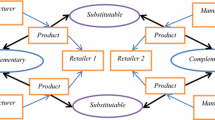Abstract
In this paper, we consider a duopoly market where two manufacturers separately produce and sell two complementary products through a common retailer as a leader–follower movement. The competition has been studied in two-echelon supply chain system and all produced products are sold by the retailer with individual product prices or with pure products’ bundling price in the non-cooperative market. The demand of each product linearly depends on prices of these two products as per their nature. Here, model for two different cases (without and with pure products’ bundling) are developed mathematically to maximize the profit of each participant of the supply chain and then corresponding optimal pricing strategies are worked out for the manufacturers and retailer. It is shown that supply chain profit for the pure bundling is better than the profit when products are sold at individual prices. Finally, the model is illustrated with numerical data to study the effects of models’ parameters in the pricing strategies and some marketing decisions are explored.






Similar content being viewed by others
References
Armstrogn, M., & Vickers, J. (2010). Competitive non-linear pricing and bundling. The Review of Economic Studies, 77(1), 30–60.
Avenali, A., D’Annunzio, A., & Reverberi, P. (2013). Bundling, competition and quality investment: A welfare analysis. Review of Industrial Organization, 43(3), 221–241.
Bhargava, H. K. (2012). Retailer-driven product bundling in a distribution channel. Marketing Science, 31(6), 1014–1021.
Brito, D., & Vasconcelos, H. (2015). Interfirm bundling and vertical product differentiation. The Scandinavian Journal of Economics, 117(1), 1–27.
Chen, J., & Bell, P. C. (2013). The impact of customer returns on supply chain decisions under various channel interactions. Annals of Operations Research, 206(1), 59–74.
Choi, J. P. (2008). Mergers with bundling in complementary markets. The Journal of Industrial Economics, 56(3), 553–577.
Choi, S. C. (1991). Price competition in a channel structure with a common retailer. Marketing Science, 10(4), 271–296.
Chu, C. S., Leslie, P., & Sorensen, A. (2011). Bundle-size pricing as an approximation to mixed bundling. The American Economic Review, 101(1), 263–303.
Estelami, H. (1999). Consumer savings in complementary product bundles. Journal of Marketing Theory and Practice, 7(3), 107–114.
Gans, J. S., & King, S. P. (2006). Paying for loyalty: Product bundling in oligopoly. The Journal of Industrial Economics, 54(1), 43–62.
Giri, R. N., Mondal, S. K., & Maiti, M. (2016). Analysis of pricing decision for substitutable and complementary products with a common retailer. Pacific Science Review A: Natural Science and Engineering, 18, 190–202.
Gürler, Ü., Öztop, S., & Şen, A. (2009). Optimal bundle formation and pricing of two products with limited stock. International Journal of Production Economics, 118(2), 442–462.
Huang, H., & Ke, H. (2017). Pricing decision problem for substitutable products based on uncertainty theory. Journal of Intelligent Manufacturing, 28(3), 503–514.
Jiang, L., & Hao, Z. (2014). On the value of information sharing and cooperative price setting. Operations Research Letters, 42(6), 399–403.
Li, M., Feng, H., Chen, F., & Kou, J. (2013). Numerical investigation on mixed bundling and pricing of information products. International Journal of Production Economics, 144(2), 560–571.
Mahmoodi, A., & Eshghi, K. (2014). Price competition in duopoly supply chains with stochastic demand. Journal of Manufacturing Systems, 33(4), 604–612.
Maiti, T., & Giri, B. (2015). A closed loop supply chain under retail price and product quality dependent demand. Journal of Manufacturing Systems, 37, 624–637.
Matutes, C., & Regibeau, P. (1992). Compatibility and bundling of complementary goods in a duopoly. The Journal of Industrial Economics, 40(1), 37–54.
Mukhopadhyay, S. K., Yue, X., & Zhu, X. (2011). A stackelberg model of pricing of complementary goods under information asymmetry. International Journal of Production Economics, 134(2), 424–433.
Raju, J. S., & Roy, A. (2000). Market information and firm performance. Management Science, 46(8), 1075–1084.
Sheikhzadeh, M., & Elahi, E. (2013). Product bundling: Impacts of product heterogeneity and risk considerations. International Journal of Production Economics, 144(1), 209–222.
Sheng, S., Parker, A. M., & Nakamoto, K. (2007). The effects of price discount and product complementarity on consumer evaluations of bundle components. Journal of Marketing Theory and Practice, 15(1), 53–64.
Tsay, A. A., & Agrawal, N. (2000). Channel dynamics under price and service competition. Manufacturing & Service Operations Management, 2(4), 372–391.
Wei, J., & Zhao, J. (2016). Pricing decisions for substitutable products with horizontal and vertical competition in fuzzy environments. Annals of Operations Research, 242(2), 505–528.
Yan, R., & Bandyopadhyay, S. (2011). The profit benefits of bundle pricing of complementary products. Journal of Retailing and Consumer Services, 18(4), 355–361.
Yan, R., Myers, C., Wang, J., & Ghose, S. (2014). Bundling products to success: The influence of complementarity and advertising. Journal of Retailing and Consumer Services, 21(1), 48–53.
Yue, X., Mukhopadhyay, S. K., & Zhu, X. (2006). A bertrand model of pricing of complementary goods under information asymmetry. Journal of Business Research, 59(10), 1182–1192.
Zhang, L., Wang, J., & You, J. (2015). Consumer environmental awareness and channel coordination with two substitutable products. European Journal of Operational Research, 241(1), 63–73.
Zhao, J., Tang, W., Zhao, R., & Wei, J. (2012). Pricing decisions for substitutable products with a common retailer in fuzzy environments. European Journal of Operational Research, 216(2), 409–419.
Zhao, J., Wei, J., & Li, Y. (2014). Pricing decisions for substitutable products in a two-echelon supply chain with firms different channel powers. International Journal of Production Economics, 153, 243–252.
Acknowledgements
The authors greatly appreciated the editors and the anonymous referees for their valuable comments and suggestions to improve the paper in the present form. Also, the first author is gratefully to University Grants Commission (UGC, India) for partially financial support to continue this research work by Innovative Research Project Grants (Ref. No. VU/Innovative/Sc/03/2015).
Author information
Authors and Affiliations
Corresponding author
Rights and permissions
About this article
Cite this article
Giri, R.N., Mondal, S.K. & Maiti, M. Bundle pricing strategies for two complementary products with different channel powers. Ann Oper Res 287, 701–725 (2020). https://doi.org/10.1007/s10479-017-2632-y
Published:
Issue Date:
DOI: https://doi.org/10.1007/s10479-017-2632-y




